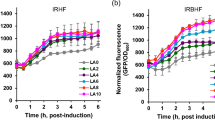Abstract
Iogen Corporation of Ottawa, Canada, has recently built a 50 t/d biomass-to-ethanol demonstration plant adjacent to its enzyme production facility. Iogen has partnered with the University of Toronto to test the C6/C5 cofermentation performance characteristics of National Renewable Energy Laboratory's metabolically engineered Zymomonas mobilis using its biomass hydrolysates. In this study, the biomass feedstock was an agricultural waste, namely oat hulls, which was hydrolyzed in a proprietary two-stage process involving pretreatment with dilute sulfuric acid at 200–250°C, followed by cellulase hydrolysis. The oat hull hydrolysate (OHH) contained glucose, xylose, and arabinose in a mass ratio of about 8:3:0.5. Fermentation media, prepared from diluted hydrolysate, were nutritionally amended with 2.5 mL/L of corn steep liquor (50% solids) and 1.2 g/L of diammonium phosphate. The estimated cost for large-scale ethanol production using this minimal level of nutrient supplementation was 4.4c/gal of ethanol. This work examined the growth and fermentation performance of xyloseutilizing, tetracycline-resistant, plasmid-bearing, patented, recombinant Z. mobilis cultures: CP4:pZB5, ZM4:pZB5, 39676:pZB4L, and a hardwood prehydrolysate-adapted variant of 39676:pZB4L (designated asthe “adapted” strain). In pH-stat batch fermentations with unconditioned OHH containing 6% (w/v) glucose, 3% xylose, and 0.75% acetic acid, rec Zm ZM4:pZB5 gave the best performance with a fermentation time of 30h, followed by CP4:pZB5 at 48h, with corresponding volumetric productivities of 1.4 and 0.89 g/(L·h), respectively. Based on the available glucose and xylose, the process ethanol yield for both strains was 0.47 g/g (92% conversion efficiency). At 48 h, the process yield for rec Zm 39676:pZB4L and the adapted strain was 0.32 and 0.34 g/g, respectively. None of the test strains was able to fermentarabinose. Acetic acid tolerance appeared to be a major determining factor in cofermentation performance.
Similar content being viewed by others
References
Foody, B. F. (2000), 21st Symposium on Biotechnology for Fuelsand Chemicals, Fort Collins, CO (abstract no. 6-01).
Foody, B. F. and Tolan, J. S. (2000), 22nd Symposium on Biotechnology for Fuels and Chemicals, Gatlinburg, TN (abstract no. 6-07).
Hinman, N. D., Wright, J. D., Hoagland, W., and Wyman, C. E. (1989), Appl. Biochem. Biotechnol. 20/21, 391–401.
McMillan, J. D. (1994), in Enzymatic Conversion of Biomass for Fuels Production, Himmel, M. E., Baker, J. O., and Overend, R. A., eds., ACS Symposium Series 566, American Chemical Society, Washington, DC, pp. 411–437.
Hahn-Hägerdal, B., Hallborn, J., Jeppsson, H., Olsson, L., Skoog, K., and Walfridsson, M. (1993), in Bioconversion of Forest and Agricultural Plant Residues, Saddler, J. N., ed., C. A. B. International, Wallingford, UK, pp. 411–437.
Zhang, M., Franden, M. A., Newman, M., McMillan, J., Finkelstein, M., and Picataggio, S. (1995), Appl. Biochem. Biotechnol. 51/52, 527–536.
Picataggio, S. K., Zhang, M., and Finkelstein, M. (1994), in Enzymatic Conversion of Biomass for Fuels Production, Himmel, M. E., Baker, J. O., and Overend, R. A., eds., ACS Symposium Series 566, American Chemical Society, Washington, DC, pp. 342–362.
Zhang, M., Eddy, C., Deanda, K., Finkelstein, M., and Picataggio, S. K. (1995), Science 267, 240–243.
Author information
Authors and Affiliations
Corresponding author
Rights and permissions
About this article
Cite this article
Lawford, H.G., Rousseau, J.D. & Tolan, J.S. Comparative ethanol productivities of different Zymomonas recombinants fermenting oat hull hydrolysate. Appl Biochem Biotechnol 91, 133–146 (2001). https://doi.org/10.1385/ABAB:91-93:1-9:133
Issue Date:
DOI: https://doi.org/10.1385/ABAB:91-93:1-9:133




